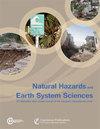中亚地区滑坡易感性综合图
IF 4.7
2区 地球科学
Q1 GEOSCIENCES, MULTIDISCIPLINARY
引用次数: 5
摘要
摘要中亚是一个构造复杂、变形活跃的地区;相关的地震活动控制着地震危险程度,由于二次和三次效应的发生,也直接影响到与滑坡等大规模运动有关的危险,滑坡每年造成大量伤亡。在气候方面,由于气候和植被带的多样性,该地区具有强烈的降雨梯度对比。该地区被部分由雪和冰川补给的大型河流所排干,这些河流穿过或终止于干旱的前滩;因此,它也受到重大河流洪水灾害的影响,主要发生在春季和夏季。只有根据仙台减少灾害风险框架的要求,考虑在不同国家之间协调一致的多灾害方法,才能应对不同灾害组合带来的挑战。这项工作是在“加强中亚金融韧性和加快降低风险”(SFRARR)项目的框架内进行的,该项目是多灾害方法的一部分,重点是中亚首次区域范围内的滑坡易感性分析。为此,在阿兰多姆森林模型中实施了最详细的滑坡清单,包括国家和跨界领土,以及几个自变量。所提出的方法代表了分辨率方面的创新(从30到70 m) 以及根据以前在中亚应用的区域滑坡易感性和危险区划模型对分析区域的扩展。最终目的是为滑坡科学家、从业者和管理人员提供一个有用的土地利用规划和风险降低战略工具。本文章由计算机程序翻译,如有差异,请以英文原文为准。
Comprehensive landslide susceptibility map of Central Asia
Abstract. Central Asia is an area characterized by complex tectonics and active deformation; the related seismic activity controls the earthquake hazard level that, due to the occurrence of secondary and tertiary effects, also has direct implications for the hazard related to mass movements such as
landslides, which are responsible for an extensive number of casualties
every year. Climatically, this region is characterized by strong rainfall
gradient contrasts due to the diversity of climate and vegetation zones.
The region is drained by large, partly snow- and glacier-fed rivers that
cross or terminate in arid forelands; therefore, it is also affected by a
significant river flood hazard, mainly in spring and summer seasons. The
challenge posed by the combination of different hazards can only be tackled by
considering a multi-hazard approach harmonized among the different
countries, in agreement with the requirements of the Sendai Framework for
Disaster Risk Reduction. This work was carried out within the framework of
the Strengthening Financial Resilience and Accelerating Risk Reduction in Central Asia (SFRARR) project as part of a multi-hazard approach and is
focused on the first landslide susceptibility analysis at a regional scale
for Central Asia. To this aim the most detailed landslide inventories,
covering both national and transboundary territories, were implemented in a
random forest model, together with several independent variables. The
proposed approach represents an innovation in terms of resolution (from 30
to 70 m) and extension of the analyzed area with respect to previous
regional landslide susceptibility and hazard zonation models applied in
Central Asia. The final aim was to provide a useful tool for land
use planning and risk reduction strategies for landslide scientists,
practitioners, and administrators.
求助全文
通过发布文献求助,成功后即可免费获取论文全文。
去求助
来源期刊
CiteScore
7.60
自引率
6.50%
发文量
192
审稿时长
3.8 months
期刊介绍:
Natural Hazards and Earth System Sciences (NHESS) is an interdisciplinary and international journal dedicated to the public discussion and open-access publication of high-quality studies and original research on natural hazards and their consequences. Embracing a holistic Earth system science approach, NHESS serves a wide and diverse community of research scientists, practitioners, and decision makers concerned with detection of natural hazards, monitoring and modelling, vulnerability and risk assessment, and the design and implementation of mitigation and adaptation strategies, including economical, societal, and educational aspects.

 求助内容:
求助内容: 应助结果提醒方式:
应助结果提醒方式:


